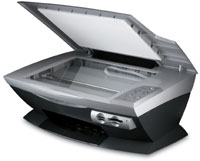Article
Summit releases comparative research on photo kiosks
The photo kiosk market is hotter than ever, with new research being released this month, and a well-known printer vendor touting its alternative to retail terminals.
December 9, 2003
The photo kiosk market is hotter than ever, with new comparative research being released this month, and a well-known printer vendor touting its alternative to retail terminals.
Rockville. Md.-based Summit Research Associates Inc. has made available its 89-page "Kiosk Industry Sector Report - Digital Photography," the analyst firm's first report on one of the fastest-growing sectors in the kiosk arena.
The Summit research studies in-depth 14 of the leading photo kiosks using a methodology designed to provide the most level playing field. The report describes each kiosk as a separate case study that includes pictures of the unit along with an example of the user interface.
Francie Mendelsohn, president of Summit Research, said she tested the kiosks herself, watched users interact with the machines, and talked with sales staff at the retail outlet in which the kiosks were deployed. She used the same test pictures stored on CD at each unit. Summit then compared output quality.
Mendelsohn cautioned the industry that photo kiosks have reached critical mass. "There is a lot at stake, so you have to do it right." She used as an example Fuji, which has gone from no photo kiosk in the United States to more than 6,000 units deployed within the past seven months.
And there is growing competition from home-based products. This week, for instance, printer vendor Lexington, Ky.-based Lexmark International, released a new product that it is positioning as an alternative to photo kiosks. With the product, PrinTrio Photo, consumers can print out digital photos from the comfort of their homes. See related story, "Lexmark intros alternative to photo kiosks."
 |
Lexmark PrinTrio |
Researching a hot area
Mendelsohn said that during her research, she identified "two locomotives headed straight for one another" threatening the photo kiosk market. One is the fact that photo kiosks display at one time an average of 16.7 images; the other is that increasingly complex digital cameras with memory cards can store as many as 3,200 pictures.
"Consumers are not going to stand there and look at 16 photos at a time with that many photos available, and especially with slow download times," she said. "This will be a bigger problem as time goes by and camera continue to store massive amounts of images." Mendelsohn said that only 4 percent of photos shot are ever printed.
|
The testing for Summit's new research was rigorous, because this type of kiosk, with so many options, demands fair comparison. The researchers did not use any editing options, selecting only default processing. Summit monitored how the processing treated facial tones, and specific colors like red.
"It didn't turn out the way you might think, that the more expensive options offer the best quality. That isn't true at all," said Mendelsohn.
She noted one interesting product, a photo kiosk from Polaroid with a patented printing process that handles 24 prints in two minutes. The kiosk hasn't yet been deployed.
Lexmark `not a threat'
Photo kiosk vendors reacted in lukewarm fashion to the news this week that printer giant Lexmark introduced a sub-$100 product positioned as a competitor to retail terminals.
"The PrinTrio is an alternative to photo kiosks as it provides the benefit of photo processing capabilities from the comfort of consumers' homes," a Lexmark spokesperson told KIOSKmarketplace.
Rob Howard, manager of marketing communications for TouchPoint Solutions Inc., makers of QuickPIX Photo Kiosk software, said, "There is a good reason photo kiosks exist and we see them as a viable business opportunity. Consumers are increasingly mobile and they want the ability to get a service where they are, not just at home."
Howard explained that consumers would have to invest time, effort and money to get the photo quality they desire, while photo kiosks are designed to be foolproof and are professionally serviced and maintained.
"Quality may be unpredictable with home systems, and may even degrade over time," he said.
He added that consumables such as ink and photo-grade paper can be expensive.
Here are prices, according to the Lexmark spokesperson:
*Photo Cartridge (six-color): $ 24.99
*Color Ink Cartridge: $ 37.99
*High Yield Color Cartridge: $ 49.99
*Black Print Cartridge: $ 28.99
*High-Yield Black Print Cartridge: $ 44.99
Said Howard, "We don't view home-based systems as a negative. They might get consumers comfortable with printing pictures again."
And, as Mendelsohn pointed out, not all consumers with digital cameras have PCs. She said in that case, such advanced editing capabilities as cropping, zooming and red-eye reduction as offered by Lexmark don't mean much.
[Editor's note: Info Touch Technologies became Tio Networks in April 2006.]













